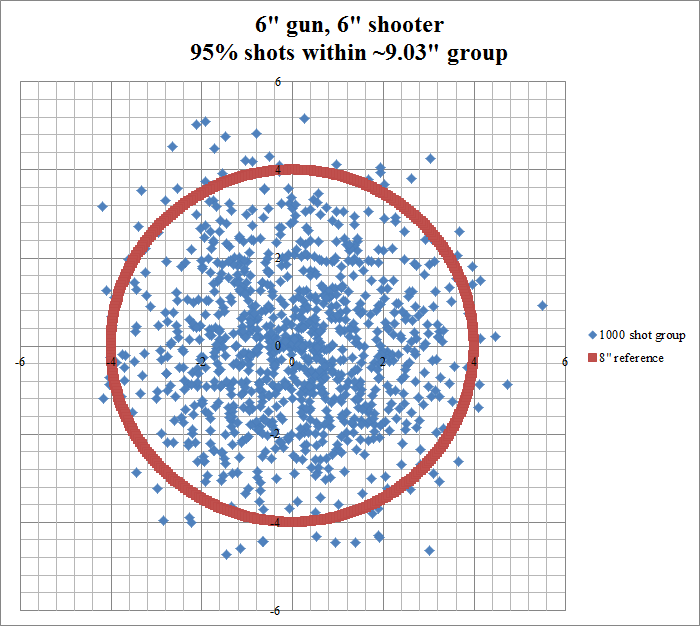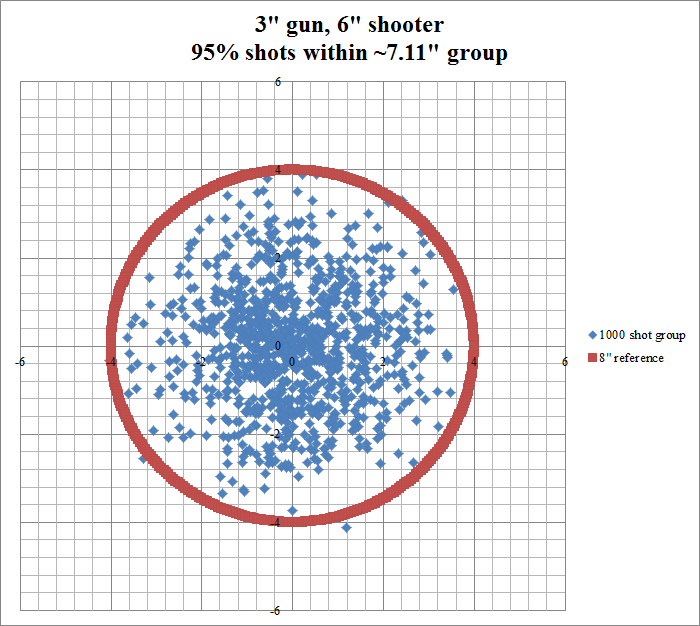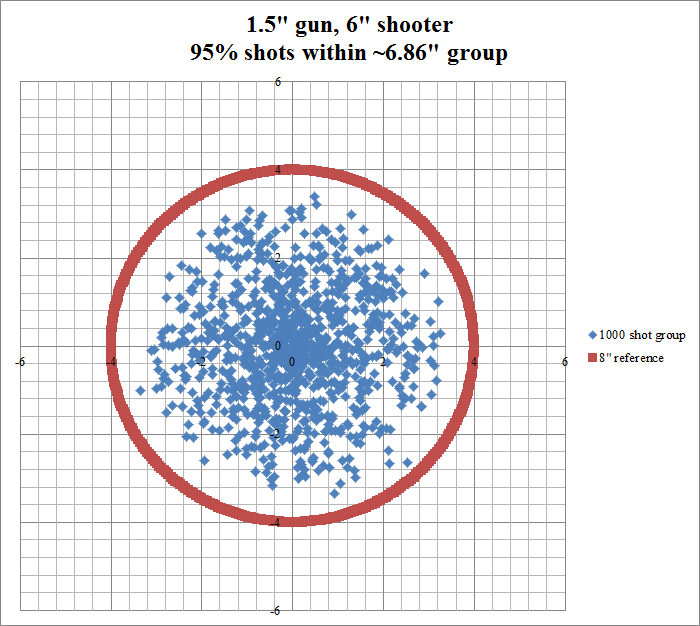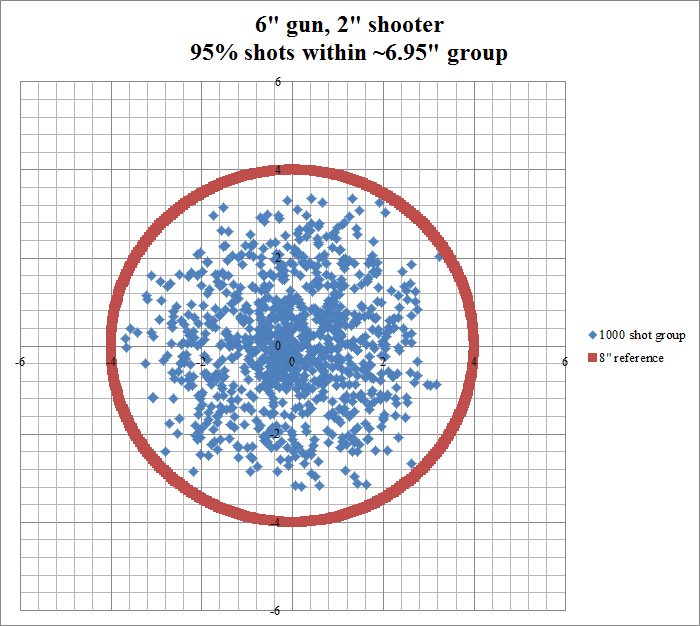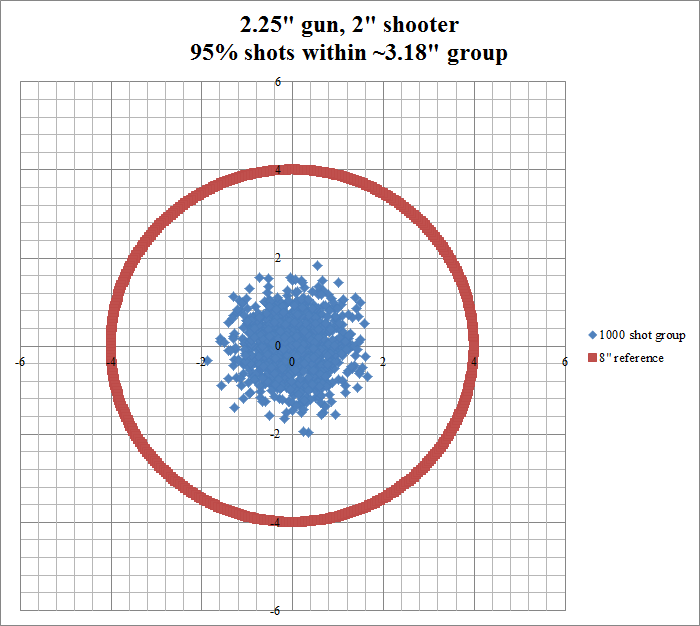At a glance Default.mp3's new images seem to corroborate what I was suggesting, which is that a better shooter will always see more benefit (both absolute and relative) with better equipment than a worse shooter.
His data is looking at what percentage of shots fall in a certain size area. I think that's a pretty good model, and that's basically what I was thinking about when I posted my numbers. However, the truth is that group shooting is a different beast. For good measure I've gone ahead and done some simulations.
Like Default.mp3, I'm assuming that the shooter and the gun are each responsible for a Gaussian distribution that's roughly a certain number of inches wide and that these two distributions add (statistical independence, which seems fair for internal gun modifications).
Where these plots diverge from his however is that I've imagined that each shooter shoots 1000 5-round groups. Each group is measured in the traditional way, by measuring the furthest distance between two points. Then I plot a histogram of the group sizes and statistics for them. Keep in mind, the average size of a 5-shot group is going to be quite different than say a 2-shot group or a 10-shot group for the same shooter.
Attachment 14875
Attachment 14876
Attachment 14877
Attachment 14878
Attachment 14879
Attachment 14880
It's not worth paying too much attention to the exact numbers for shooter and barrel precision, they are not very meaningful on their own, and it's better to think of them as placeholders for "better shooter", "worse shooter", "better barrel", and so on.
Here are some abbreviated results comparing 2" barrel to 1" barrel average 5-shot group sizes for various shooters:
3" shooter: 3.26" vs. 2.93" = 0.33" improvement (10%)
2" shooter: 2.63" vs. 2.04" = 0.59" improvement (22%)
1" shooter: 2.04" vs. 1.31" = 0.73" improvement (36%)
0.5" shooter: 1.9" vs. 1.03" = 0.87" improvement (46%)
Again, this suggests the better shooter sees more improvement regardless of whether the shooters are better or worse than the equipment itself.
My code could be screwed up, and to be honest I defined shooter and barrel precision by a hand-calibrated confidence interval that could be totally bogus. That shouldn't really effect the conclusion. But, if people want to look for errors or experiment with different group sizes, numbers of trials, and parameters, here's the python code:
Code:
import numpy as np
import matplotlib.pyplot as plt
from scipy.spatial.distance import pdist
num_of_groups = 1000
shots_per_group = 5
shooter_precision = 0.5 # inches
barrel_precision = 0 # inches
confidence_tuning = 0.3 # 0.3 -> precision = full-width-quarter-max
def cov(precision):
return [[(confidence_tuning * precision)**2, 0], [0, (confidence_tuning * precision)**2]]
def samples(precision):
return np.random.multivariate_normal([0,0], cov(precision), shots_per_group)
def group_size(group):
return np.amax(pdist(group))
def group_sizes(shooter_prec, barrel_prec):
output = []
for i in range(num_of_groups):
group = np.add(samples(shooter_prec), samples(barrel_prec))
output.append(group_size(group))
return output
dataset = group_sizes(shooter_precision, barrel_precision)
# Plot results:
fig = plt.figure()
fig.suptitle(str(shooter_precision)+'-inch Shooter with '+str(barrel_precision)+'-inch Barrel', fontsize=14, fontweight='bold')
ax = fig.add_subplot(111)
fig.subplots_adjust(top=0.85)
ax.set_title(str(num_of_groups)+' '+str(shots_per_group)+'-shot groups\naverage group size: '+"{0:.2f}".format(np.average(dataset))+' inches, std. dev.: '+ "{0:.2f}".format(np.std(dataset))+" inches")
ax.set_xlabel('size (inches)')
ax.set_ylabel('# of groups')
ax.hist(dataset, bins=np.linspace(0,11,22))
plt.show()
If I wanted to do the actual theoretical math to verify this, which would let us remove the Gaussian assumption and get a parameter-independent result, I wouldn't be bored enough to be on PF.
But I agree with voodoo_man, it's all bullshit unless it adds up in meatspace. So, if SLG is willing to provide all the ammo, equipment, location, and and his time, I will gladly shoot 1000 5-round groups with him........for science!

ETA: The confidence interval was total BS. I retweaked it so that shooter and barrel precisions now correspond to full-width-quarter-maximum, which seems to correspond nicely to average 5-round group capabilities.



 Reply With Quote
Reply With Quote



